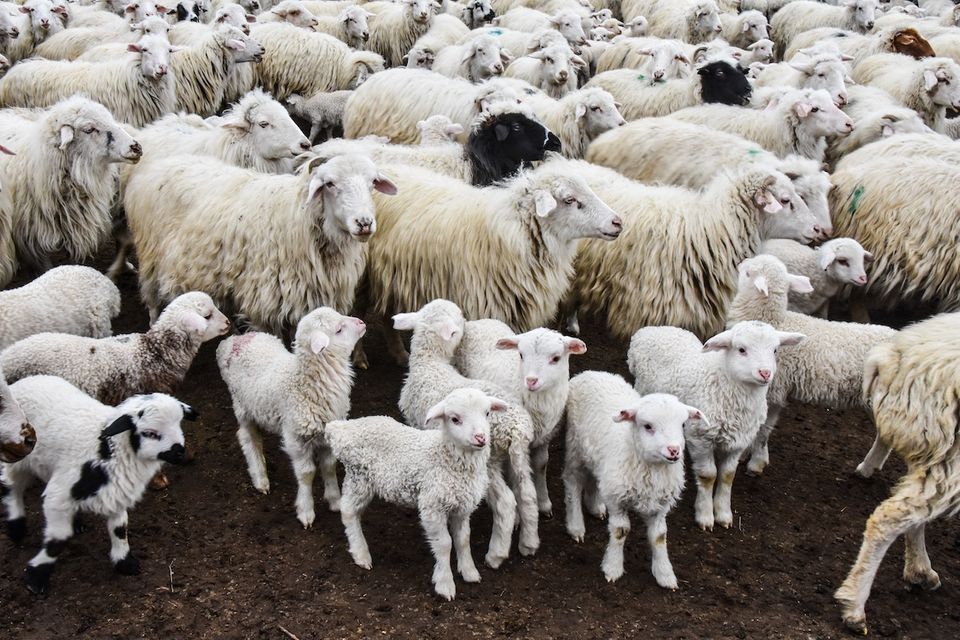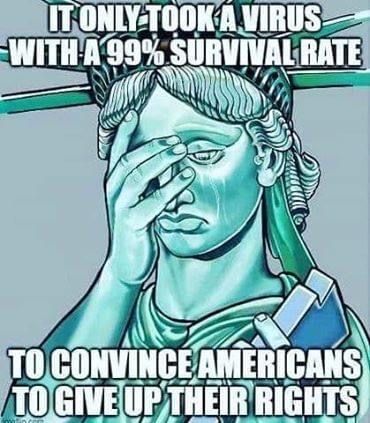Herd immunity?

Suppose you were to work for me, and I were to send you out to do an errand, say, getting some groceries. I tell you there is a 99% chance you will survive. Would you go?
My guess is that you probably would. You need a job, life has risks, and 99% seems like pretty good odds.
Now suppose I send a hundred of you out to do the same task. I gather you together, tell you what I need done, and tell you each of you has a 99% chance you will survive. Now, if you’re a bit clever, you’ll realize that, statistically, one of you won’t make it back.
You could all get lucky, to be sure. As it happens, each of you having a 99% chance of survival doesn’t necessarily mean 99 of you will survive and 1 will die. But, as you add more people with the same odds the random lucky or unlucky ones smooth out, so that effectively 99% of the sample will survive and 1% will die.
- Table of Contents
Memes

I found this meme on Facebook recently. Perhaps you have seen it too, or a similar one. It implies that since COVID-19 has a 99% survival rate it isn’t bad enough to warrant the mandated response to it. I’ve heard talk off and on about herd immunity, and likely you have as well. Herd immunity the idea that once enough people get sick and develop an immunity to the virus its spread will effectively be stopped. People say things like, “We should all get it and get over it and move on with our lives.”
Technically, that works. But is it a good idea?
Math
I’m unapologetically a big fan of science and math. I know I’m a fairly emotional guy, but I also pretty much make my living off of logical reasoning. So I did the math.
First off, according to the United States Census Bureau, the population of the US was last estimated to be 328,239,523, as of July 1, 2019.
Second, for herd immunity to take place a large portion of the population has to contract the virus. The exact amount could vary depending on the disease, but according to Johns Hopkins and the Mayo Clinic, at least 70% of the population of the would need to contract and recover from this coronavirus in order for us to achieve herd immunity.
Third, we will assume the recovery rate is 99% as stated in the meme. There are various estimates for what the recovery rate is, due to changing conditions and health demographics. The estimates range from 97% to 99.75%, so 99% seems like a relatively good number to work with. A 99% recovery rate means also that there is a 1% death rate.
100% total - 99% recovery = 1% death
So, we can do some simple math. I will round all the calculations to the nearest whole person at the end of each equation, to keep it simple. The population multiplied times the percentage that will need to contract the virus to achieve herd immunity gives us the number of people who will get sick with the coronavirus:
328,239,523 x .70 = 229,767,666
Next, we can multiply this by the percentage which will die of the virus. This results in the number of fatalities required for herd immunity.
229,767,666 x .01 = 2,297,677
This is the cost of herd immunity. 2,297,677 people would die.Dissent and Rebuttal
Now, I don't want to neglect that this number could be lowered by specifically isolating those who are particularly at risk of dying from COVID-19. The problem here, though, is that it is somewhat difficult to know who is specifically at risk, locate them, give them the message that they need to stay inside for a few weeks, and provide for their needs during that time.
To begin with, we don't have a foolproof set of indicators to determine who is most at risk or a foolproof list of who would meet those indicators. We would need know the health of every person in the US and be able to compare against specific conditions which lead to complications in COVID-19, which we simply don't have. If we did have that information and convinced those people to stay inside, we would need to ensure that we had people available to provide for all of their needs for resources from outside their home, such as groceries, the availability of those items (no panic buying), and protections to ensure they would get paid and ideally retain their jobs.
Assuming that could be done perfectly, and no one from the 70% who contracted COVID-19 died, which is a big assumption, there is still the concern of lasting effects from the virus. This is a lesser concern than death, to be sure, but nevertheless there are concerns that many people who get the virus could suffer from permanent heart, lung, or neurological damage. To the best of my knowledge we do not have any data yet on who is most susceptible to these lasting conditions.
Example
Sweden, controversially, opted to take a herd immunity approach. So how did they do?
Obviously the pandemic is not yet over, so a final verdict cannot be made. Politico notes that many people in Sweden are following mask and social distancing guidelines despite their being suggested rather than mandated, and many of the deaths in Sweden have been in long term care facilities, which they failed to properly isolate. The Financial Times has reported that Sweden's economy is faring well, potentially due to their approach, although it is not better than neighboring countries with more restrictive approaches.
Nevertheless, both of these, Politico and the Financial Times, as well as the New York Times and Forbes (which author has strong credentials), have reported that the per capita death toll in Sweden is, to date, significantly higher than that of most other countries, including the United States.
Perspective
2,977 people died in the 9/11 terrorist attack, and we started a war over it.
Those attacks were brutal and tragic. I know many people are still outraged about 9/11. We still have heightened security and airports and military bases remain on a higher alert level. Each year people recount where they were when they heard the news that 2,977 lives had ended before their time.
Will you recall where you were when 2,297,677 people died so we could resume commerce? Or will you recall where you were when you stayed inside to protect them and when you got the news that a vaccine had been developed?
This isn't just my opinion, friends. This is math, based on the data currently available to us from scientists. Not only that, but this only considers deaths. There is increasing evidence, as I mentioned above, that COVID-19 may cause long term health problems in some cases due to the severity of the illness, so many of the survivors in the herd immunity scenario would live with new health problems for years to come.
The numbers don't lie. Achieving "herd immunity," "getting it and getting over it," or "exercising our rights," would come at a terrible cost.
Now, this doesn’t mean we should despair! Fortunately herd immunity is not the only way for us to stop this virus. If we take regulations seriously and follow the best medical advice, we can effectively stop the virus, as many other countries have, without reaching the case count necessary for herd immunity. Or, we can develop a vaccine, producing herd immunity without the illness.
Herd immunity seems appealing because of its potential to be a fast solution, but the cost of life is approaching the casualties of every war in US history. In my opinion, this leaves herd immunity as the default end to the pandemic if we fail to stop it, rather than a viable option to pursue.